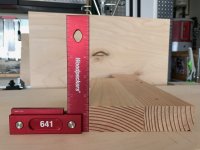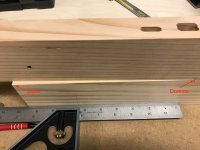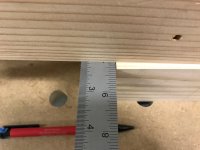My Domino XL doesn't cut mortises parallel to fence/reference surface, so when the opposite pieces are joined using a single domino (which shows how well the mortise is aligned to the reference surface), the error is doubled and the pieces are skewed/twisted from one another on the referenced surfaces.
I had tried all suggestions, lock height before locking fence, plunge slower, use new bit, etc. I finally was able to send it in for repair, but the response was very disappointing.
I got a call from Festool service and they said the machine was within spec. They asked about the problem and I described that I was using the Seneca domi-plate. They said they can't be responsible if I was using another product with the domino and that the domino XL was not designed for stock thinner than 1". Ok, fair enough.
I did, however, describe that I had the same problem mortising material thicker than 1" and had the same problem. The response was that maybe I was plunging too fast or not holding the tool flush to the surface. I insisted that I was very careful and made sure I plunged carefully and slowly and that the fence was flat on the reference surface. The response I got was that wood is a natural material and not always flat or square. Clearly not what I wanted to hear. I then asked how the tool was tested. It sounded like it was put in a rig that could test tolerance precisely. I asked that they just have someone use the tool normally and just try to join two pieces of stock with a single domino and if the pieces were aligned perfectly, then I could accept the user error explanation. He said he'd try and make the request.
I don't hear anything after that and I get the tool back. However, nothing changed and I still consistently get skewed pieces. So to ensure it wasn't the unevenness of the wood causing the issue, I cut and planed new stock greater than 1" thick to test. I also used a new 8mm bit.
The pictures show the stock is square (first picture with reference surface facing down) so there shouldn't be an issue with an uneven wood surface. I get a skew of almost a quarter inch 9.5" out from where the single domino is. I tried many times and continue to get skew. I even tried holding the fence handle with my opposite hand to see if it was something to do with my more dominant hand. I still got skew in the same direction. The only thing that seemed to result in a small improvement (i.e., less skew) is if I put near zero pressure on the fence handle. I can only guess that there is some flex somewhere in the tool when the fence has to support some amount of weight from the back of the tool.
Normally, I'm guessing I use a 50/50 to 60/40 weight distribution on the front handle/back handle when making plunges. I assume this is normal to ensure enough weight is placed on the front handle to hold the fence square. In any case, would be interested to hear how others distribute weight for the front/back and whether you get similar skew with one domino. Also, just to be clear, I am being very careful and verifying that the fence is flush to the reference face no matter what the weight distribution is on the front and rear handle, but the weight distribution seems to change the accuracy.
I also got skew when using the base to reference the mortise, although the amount of skew was a little less
Anyway, pretty disappointed in what should be a well-calibrated tool from the factory.[attachimg=1][attachimg=2][attachimg=3]
I had tried all suggestions, lock height before locking fence, plunge slower, use new bit, etc. I finally was able to send it in for repair, but the response was very disappointing.
I got a call from Festool service and they said the machine was within spec. They asked about the problem and I described that I was using the Seneca domi-plate. They said they can't be responsible if I was using another product with the domino and that the domino XL was not designed for stock thinner than 1". Ok, fair enough.
I did, however, describe that I had the same problem mortising material thicker than 1" and had the same problem. The response was that maybe I was plunging too fast or not holding the tool flush to the surface. I insisted that I was very careful and made sure I plunged carefully and slowly and that the fence was flat on the reference surface. The response I got was that wood is a natural material and not always flat or square. Clearly not what I wanted to hear. I then asked how the tool was tested. It sounded like it was put in a rig that could test tolerance precisely. I asked that they just have someone use the tool normally and just try to join two pieces of stock with a single domino and if the pieces were aligned perfectly, then I could accept the user error explanation. He said he'd try and make the request.
I don't hear anything after that and I get the tool back. However, nothing changed and I still consistently get skewed pieces. So to ensure it wasn't the unevenness of the wood causing the issue, I cut and planed new stock greater than 1" thick to test. I also used a new 8mm bit.
The pictures show the stock is square (first picture with reference surface facing down) so there shouldn't be an issue with an uneven wood surface. I get a skew of almost a quarter inch 9.5" out from where the single domino is. I tried many times and continue to get skew. I even tried holding the fence handle with my opposite hand to see if it was something to do with my more dominant hand. I still got skew in the same direction. The only thing that seemed to result in a small improvement (i.e., less skew) is if I put near zero pressure on the fence handle. I can only guess that there is some flex somewhere in the tool when the fence has to support some amount of weight from the back of the tool.
Normally, I'm guessing I use a 50/50 to 60/40 weight distribution on the front handle/back handle when making plunges. I assume this is normal to ensure enough weight is placed on the front handle to hold the fence square. In any case, would be interested to hear how others distribute weight for the front/back and whether you get similar skew with one domino. Also, just to be clear, I am being very careful and verifying that the fence is flush to the reference face no matter what the weight distribution is on the front and rear handle, but the weight distribution seems to change the accuracy.
I also got skew when using the base to reference the mortise, although the amount of skew was a little less
Anyway, pretty disappointed in what should be a well-calibrated tool from the factory.[attachimg=1][attachimg=2][attachimg=3]



